Transcription of UNIT 1 CHARACTERISTICS OF ELECTRICAL DRIVES Speed ...
1 UNIT 1 CHARACTERISTICS OF ELECTRICAL DRIVES Speed torque CHARACTERISTICS of various types of loads and DRIVES motors: Classification of load torques: 1. Active Load torques 2. Passive Load torques Active Load Torques: Load torques which have the potential to drive the motor under equilibrium conditions are called active load torques. Load torques usually retain sign when the drive rotation is changed. Passive Torque: Load torques which always oppose the motion and change their sign on the reversal of motion are called passive load torques.
2 Torque due to friction cutting Passive torque. Components of load torques: 1. Friction Torque (TF) The friction torque (TF) is the equivalent value of various friction torques referred to the motor shaft. 2. Windage Torque (Tw) When a motor runs, the wind generates a torque opposing the motion. This is known as the winding torque. 3. Torque required to do useful mechanical work (Tm) Nature of the torque depends of type of load. It may be constant and independent of Speed , some function of Speed , may be time invariant or time variant.
3 The nature of the torque may change with the change in the loads mode of operation. CHARACTERISTICS of different types of load: In electric DRIVES the driving equipment is an electric motor. Selection of particular type of motor driving an m/c is the matching of Speed -torque CHARACTERISTICS of the driven unit and that of the motor. Different types of loads exhibit different Speed torque CHARACTERISTICS . Most of the industrial loads can be classified into the following 4 general categories: 1. Constant torque type load.
4 2. Torque proportional to Speed (generator type load) 3. Torque proportional to square of the Speed (fan type load) 4. Torque inversely proportional to Speed (constant power type load) 1. Constant Torque Characteristic: The Speed torque characteristic of this type of load is given by T=K. Working motor have each mechanical nature of work like shaping , cutting, grinding or sharing, require constant torque irrespective of Speed . Similarly cranes during the hoisting. Similarly cranes during the hoisting and conveyors handling constant weight of material / unit, time also exhibit this type of CHARACTERISTICS .
5 Torque proportional to Speed : Separately executed dc generators connected to a constant resistance load, eddy current brakes and calendaring m/cs have a Speed torque CHARACTERISTICS m/cs have a Speed torque CHARACTERISTICS given by T= Kw. Torque propositional to square of the Speed : Load Torque Square of Speed Example: Fans, Rotary pumps, compressors, ship propellers. The Speed torque CHARACTERISTICS of this type of load is given by Torque inversely propositional to Speed : In such types of loads, torque is inversely proportional to Speed or load power remains constant.
6 : Lathes, boring m/cs, milling m/cs, steel mill coiler and electric traction load. This type of CHARACTERISTICS is given by Most of the load require extra effort at the time of starting to overcome static friction. In power application it is known as brake away torque and load control engineers call it stiction . Because of stiction, the Speed torque CHARACTERISTICS of the load is modified near to zero Speed . Joint Speed torque CHARACTERISTICS Equilibrium Speed of motor-load system can be obtained when motor torque equals the load torque.
7 Electric drive system will operate in steady state at this Speed , provided it is the Speed of stable state equilibrium. Concept of steady state stability has been developed to readily evaluate the stability of an equilibrium point from the steady state Speed torque curves of the motor and load system. In most of the ELECTRICAL DRIVES , the ELECTRICAL time constant of the motor is negligible compared with the mechanical time constant. During transient condition, ELECTRICAL motor can be assumed to be in ELECTRICAL equilibrium implying that steady state Speed torque curves are also applicable to the transient state operation.
8 Now, consider the steady state equilibrium point A shown in figure below Now consider equilibrium point B which is obtained when the same motor DRIVES another load as shown in the figure. A decrease in Speed causes the load torque to become greater than the motor torque, electric drive decelerates and operating point moves away from point B. Similarly when working at point B and increase in Speed will make motor torque greater than the load torque, which will move the operating point away from point B. Basics of Regenerative Braking In the regenerative braking operation, the motor operates as generator, while it is still connected to the supply.
9 Here, the motor Speed is greater than the synchronous Speed . Mechanical energy is converted into ELECTRICAL energy, part of which is returned to the supply and rest of the energy is last as heat in the winding and bearings of ELECTRICAL machines pass smoothly from motoring region to generating region, when over driven by the load. An example of regenerative braking is shown in the figure below. Here an electric motor is driving a trolley bus in the uphill and downhill direction. The gravity force can be resolved into two components in the uphill direction.
10 One is perpendicular to the load surface (F) and another one is parallel to the road surface Fl. The parallel force pulls the motor towards bottom of the hill. If we neglect the rotational losses, the motor must produce force Fm opposite to Fl to move the bus in the uphill direction. Here the motor is still in the same direction on both sides of the hill. This is known as regenerative braking. The energy is exchange under regenerative braking operation is power flows from mechanical load to source. This operation is indicated as shown in the figure below in the first quadrant.

